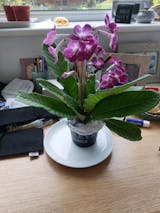










Peacock Plant - Calathea makoyana
Scientific Name
Calathea makoyana (Makoy's basket-plant)
Common Name
Peacock Plant Goeppertia, Cathedral Windows
Origin
Native to Eastern Brazil
Description
The patterns of this calathea's leaves give it its various common names, being compared to a peacock's tail or cathedral windows due to the varying shades of shimmering green across its leaves. Watch with excitement each time a new leaf grows through, maturing from pale green to richer, darker foliage and creating a miniature forest of gorgeous leaves. The Peacock Plant will repay your care with stunning foliage; give it a humid location not too far from a window and you'll enjoy its leaves for a long time.
Light
Thrives in bright, indirect sunlight; this calathea is not tolerant to darker corners.
Water
Allow the top few inches of soil to dry out in between watering; if possible, use rainwater rather than tapwater, or at least allow tap water to sit out for 24 hours to allow chemicals in it to settle. Water with tepid or lukewarm water to avoid shocking the plant.
Humidity
This plant needs high humidity, so will appreciate regular misting and not being too close to a radiator or other heat source which might dry it out.
Soil
Plant in fast draining, but moisture retentive soil. A mix with added bark or perlite would be ideal. Repot every two years in spring, and water a day in advance to combat transplant shock.
Food
Feed every four waters in the growing season, reduce to every six in autumn and winter. Pre-water the soil before applying 'ready to use' products to protect the roots.
Temperature
Ideal temperature is above 20°C; make sure it does not get colder than 12°C in winter.
Pet-safe
Yes, but too much nibbling won't be good for pets, small humans or the plant!
Sprouts Top Tips
You can pinch out the topmost growths of this plant to promote bushier growth and keep your plant looking amazing!
Did you know?
The name 'calathea', from the Greek καλαθος ('basket'), comes from the use of the plant's waxy leaves to make waterproof baskets and transport fish in South America






